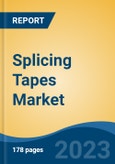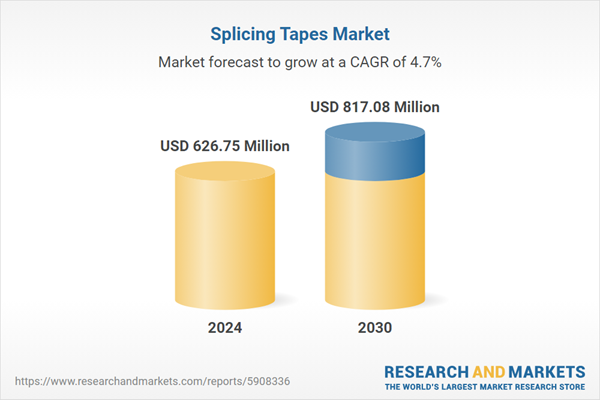Speak directly to the analyst to clarify any post sales queries you may have.
10% Free customizationThis report comes with 10% free customization, enabling you to add data that meets your specific business needs.
The packaging industry stands as one of the primary end-users of splicing tapes, driven by rapid growth in e-commerce, evolving consumer behavior, and increasing demand for sustainable packaging. Packaging manufacturers rely on high-speed automation, where any halt in production can result in significant cost implications. Splicing tapes ensure continuous material feed, boosting throughput and operational reliability. Moreover, their compatibility with various substrates, including flexible packaging films, cartons, and paperboard, makes them highly versatile.
Recent technological advancements in adhesive chemistry and tape design have led to the development of high-performance splicing tapes offering superior adhesion, temperature resistance, and durability. Modern tapes are engineered for use under extreme processing conditions, such as UV curing, high temperatures, and pressure-sensitive environments, which are common in printing and lamination lines. These improvements support enhanced performance across a wide range of substrates and enable precise application in automated systems.
Key Market Drivers
Increasing Demand for Splicing Tapes in the Packaging Industry is Major Factor for Splicing Tapes Market Growth
The packaging industry has emerged as a major driver of growth for the global splicing tapes market. With the rapid expansion of e-commerce, increasing consumer demand for packaged goods, and growing emphasis on sustainable and high-speed packaging operations, the need for efficient and reliable adhesive solutions like splicing tapes is on the rise. Splicing tapes play a crucial role in maintaining continuous production in packaging lines by seamlessly joining two webs or rolls of materials such as paper, plastic film, and foil. This allows for uninterrupted processing, significantly reducing downtime and increasing productivity an essential requirement in today’s fast-paced packaging environments.The global demand for packaging is projected to reach USD 2.23 trillion by 2050, driven by rising population levels and the growing need for safe, efficient packaging to protect and preserve goods. This long-term growth trajectory highlights the increasing scale and complexity of packaging operations, where splicing tapes play a vital role in ensuring uninterrupted, high-speed production. As packaging lines expand to meet global demand, the need for reliable, high-performance splicing solutions will rise, reinforcing the critical importance of splicing tapes in maintaining efficiency, minimizing downtime, and supporting continuous manufacturing across the packaging industry.
The shift toward automation and high-speed converting machinery in the packaging sector has heightened the demand for high-performance splicing tapes that can withstand extreme mechanical stress, temperature variations, and high line speeds. These tapes ensure strong adhesion, minimal residue, and clean splicing, which are critical for minimizing defects and material waste in packaging operations. As manufacturers increasingly adopt smart manufacturing practices and strive for operational efficiency, splicing tapes are becoming indispensable in achieving seamless transitions in production without halting operations.
Additionally, the growing demand for flexible packaging solutions used widely in food, beverages, pharmaceuticals, and personal care products further supports the rising consumption of splicing tapes. Flexible packaging materials often require precise and reliable splicing to maintain packaging integrity and meet stringent quality standards. Splicing tapes provide the performance needed to support these requirements across diverse packaging substrates.
Sustainability trends are also playing a role in shaping the splicing tape landscape. As packaging companies seek environmentally responsible materials and processes, adhesive manufacturers are developing eco-friendly, solvent-free, and recyclable splicing tapes to align with the industry's evolving priorities. These innovations not only reduce the environmental footprint but also enhance the value proposition of splicing tapes in sustainable packaging.
The growing demand for high-speed, efficient, and sustainable packaging processes is a key factor fueling the expansion of the global splicing tapes market. As the packaging industry continues to scale and diversify, the role of splicing tapes as a critical enabler of production efficiency and quality will remain central to market growth. Manufacturers that innovate to meet the evolving needs of the packaging sector are well-positioned to capitalize on this growth trajectory.
Key Market Challenges
Rising Raw Material Costs
The global Splicing Tapes market is facing a significant impediment in the form of rising raw material costs. Splicing tapes are essential in various industries, including manufacturing, printing, and packaging, for their role in seamlessly joining materials. However, these tapes are produced using materials such as specialty adhesives, backing materials, and release liners, all of which can be subject to price volatility. Fluctuations in the prices of these raw materials can substantially impact the overall production costs of splicing tapes, squeezing profit margins for manufacturers. In response, some producers may raise tape prices, potentially dissuading price-sensitive consumers and limiting market growth. Additionally, the uncertainty associated with raw material costs can disrupt supply chains and strain inventory management.To overcome this challenge and stimulate growth in the Splicing Tapes market, companies must explore strategies like sourcing raw materials from diverse suppliers, investing in inventory management systems, and optimizing production processes to enhance cost-efficiency. By mitigating the impact of rising raw material costs, the industry can continue to provide essential solutions to various sectors while maintaining competitiveness and market expansion potential.
Key Market Trends
Automation and Industry 4.0Automation and Industry 4.0 are pivotal trends driving the growth of the global splicing tapes market. In an era marked by digital transformation and smart manufacturing, industries are increasingly adopting automated processes and embracing Industry 4.0 principles to enhance productivity and efficiency. Splicing tapes, which are used for joining or connecting materials in various manufacturing processes, play a crucial role in automation.
They enable seamless transitions during production, reduce downtime, and improve overall manufacturing efficiency. Automated systems integrated with splicing tape applications can perform tasks with precision and consistency, leading to higher product quality and cost savings. Industry 4.0 technologies, such as Internet of Things (IoT) sensors and data analytics, are being incorporated into splicing tape processes. These advancements allow for real-time monitoring of tape performance, predictive maintenance, and data-driven decision-making to optimize production.
As industries continue to embrace automation and Industry 4.0 practices to remain competitive and meet evolving consumer demands, the global splicing tapes market is experiencing substantial growth. Companies that innovate and align their splicing tape offerings with these trends are well-positioned to cater to the changing landscape of modern manufacturing.
Key Market Players
- PPI Adhesive Products (C.E.)
- Nitto Denko Corporation.
- Avery Dennison Corporation.
- Scapa
- Tesa Tapes (India) Private Limited
- Intertape Polymer Group
- Shurtape Technologies, LLC
- ECHOtape
- ORAFOL Europe GmbH.
- Adhesives Research, Inc.
- INDUSTRIAS TUK
Report Scope:
In this report, the Global Splicing Tapes Market has been segmented into the following categories, in addition to the industry trends which have also been detailed below:Splicing Tapes Market, By Type:
- Acrylic
- Rubber
- Silicone
Splicing Tapes Market, By Application:
- Electronics
- Labelling
- Packaging
- Paper & Printing
Splicing Tapes Market, By Region:
- Asia-Pacific
- China
- India
- Japan
- Australia
- South Korea
- North America
- United States
- Canada
- Mexico
- Europe
- France
- United Kingdom
- Italy
- Germany
- Spain
- South America
- Brazil
- Argentina
- Colombia
- Middle East & Africa
- South Africa
- Saudi Arabia
- UAE
- Kuwait
- Turkey
- Egypt
Competitive Landscape
Company Profiles: Detailed analysis of the major companies present in the Global Splicing Tapes Market.Available Customizations:
With the given market data, the publisher offers customizations according to a company's specific needs. The following customization options are available for the report.Company Information
- Detailed analysis and profiling of additional market players (up to five).
This product will be delivered within 1-3 business days.
Table of Contents
Companies Mentioned
The leading companies profiled in this Splicing Tapes market report include:- PPI Adhesive Products (C.E.)
- Nitto Denko Corporation.
- Avery Dennison Corporation.
- Scapa
- Tesa Tapes (India) Private Limited
- Intertape Polymer Group
- Shurtape Technologies, LLC
- ECHOtape
- ORAFOL Europe GmbH.
- Adhesives Research, Inc.
- INDUSTRIAS TUK
Table Information
| Report Attribute | Details |
|---|---|
| No. of Pages | 180 |
| Published | September 2025 |
| Forecast Period | 2024 - 2030 |
| Estimated Market Value ( USD | $ 626.75 Million |
| Forecasted Market Value ( USD | $ 817.08 Million |
| Compound Annual Growth Rate | 4.7% |
| Regions Covered | Global |
| No. of Companies Mentioned | 12 |









